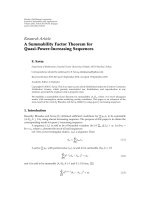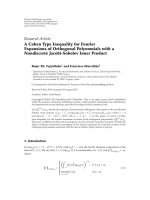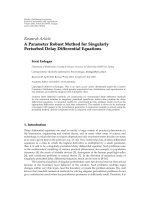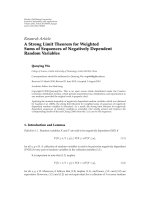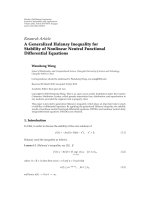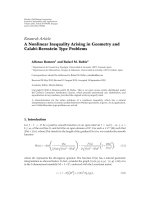Báo cáo hóa học: " Research Article A Nonlinear Decision-Based Algorithm for Removal of Strip Lines, Drop Lines, Blotches, Band Missing and Impulses in Images and Videos" docx
Bạn đang xem bản rút gọn của tài liệu. Xem và tải ngay bản đầy đủ của tài liệu tại đây (3.94 MB, 10 trang )
Hindawi Publishing Corporation
EURASIP Journal on Image and Video Processing
Volume 2008, Article ID 485921, 10 pages
doi:10.1155/2008/485921
Research Article
A Nonlinear Decision-Based Algorithm for
Removal of Strip Lines, Drop Lines, Blotches, Band
Missing and Impulses in Images and Videos
S. Manikandan and D. Ebenezer
Dig ital Signal Processing Laboratory, Sri Krishna College of Engineering and Technology, Coimbatore,
Anna University, Tamilnadu 641008, India
Correspondence should be addressed to S. Manikandan,
Received 11 May 2007; Revised 3 December 2007; Accepted 21 July 2008
Recommended by Benoit Macq
A decision-based nonlinear algorithm for removal of strip lines, drop lines, blotches, band missing, and impulses in images is
presented. The algorithm performs two simultaneous operations, namely, detection of corrupted pixels and estimation of new
pixels for replacing the corrupted pixels. Removal of these artifacts is achieved without damaging edges and details. The algorithm
uses an adaptive length window whose maximum size is 5
×5 to avoid blurring due to large window sizes. However, the restricted
window size renders median operation less effective whenever noise is excessive in which case the proposed algorithm automatically
switches to mean filtering. The performance of the algorithm is analyzed in terms of mean square error [MSE], peak-signal-
to-noise ratio [PSNR], and image enhancement factor [IEF] and compared with standard algorithms already in use. Improved
performance of the proposed algorithm is demonstrated. The advantage of the proposed algorithm is that a single algorithm can
replace several independent algorithms required for removal of different artifacts.
Copyright © 2008 S. Manikandan and D. Ebenezer. This is an open access article distributed under the Creative Commons
Attribution License, which permits unrestricted use, distribution, and reproduction in any medium, provided the original work is
properly cited.
1. INTRODUCTION
It is well known that linear filters are not quite effective in
the presence of non-Gaussian noise. In the last decade, it
has been shown that nonlinear digital filters can overcome
some of the limitations of linear digital filters [1]. Median
filters are a class of nonlinear filters and have produced
good results where linear filters generally fail [2]. Median
filters are known to remove impulse noise and preserve
edges. There are a wide variety of median filters in the
literature. In remote sensing, artifacts such as strip lines,
drop lines, blotches, band missing occur along with impulse
noise. Standard median filters reported in the literature
do not address these artifacts. Strip lines are caused by
unequal responses of elements of a detector array to the
same amount of incoming electromagnetic energy [3].
This phenomenon causes heterogeneity in overall brightness
of adjacent lines. Drop line [3]occurswhenadetector
does not work properly for a short period. Impulse noise
appears when disturbing microwave energies are present
or the sensor/detector is degraded. Band missing [3]isa
seriousproblemandiscausedbycorruptionoftwoor
more drop/strip lines continuously. For removal of these
artifacts, generally separate methods are employed. Strip
lines and drop lines are considered as line scratches by
Silva and Corte-Real [4] for image sequences. According
to him, a positive type film suffers from bright scratches
and negative film suffers from dark scratches. Milady has
considered only the dark scratches; if bright scratches exist
he inverted them and used the same algorithm. Silva and
Corte-Real [4] gives a remedy for removing the blotches
and line scratches in images. He has considered only vertical
lines (which are narrow) and the blotches as impulsive with
constant intensity having irregular shapes. Kokaram [5]has
given a method for removal of scratches and restoration
of missing data in the image sequences based on temporal
2 EURASIP Journal on Image and Video Processing
filtering. Additionally, impulse noise is a standard type of
degradation in remotely sensed images. This paper considers
application of median-based algorithms for removal of
impulses, strip lines, drop lines, band missing, and blotches
while preserving edges. It has been shown recently that
an adaptive length algorithm provides a better solution
for removal of impulse noise with better edge and fine
detail preservation. Several adaptive algorithms [6–9]are
available for removal of impulse noises. However, none of
these algorithms addressed the problem of strip lines, drop
lines, blotches, and band missing in images. The objective
of this paper is to propose an adaptive length median/mean
algorithm that can simultaneously remove impulses, strip
lines, drop lines, band missing, and blotches while preserving
edges. The advantage of the proposed algorithm is that a
single algorithm with improved performance can replace
several independent algorithms required for removal of
different artifacts.
2. DEGRADED IMAGE MODEL
Blotches are impulsive-type degradations randomly dis-
tributed with irregular shapes of approximately constant
intensity. These artifacts last for one frame. In the degraded
regions there is no correlation between successive frames.
Blotches are originated by dust, warping of the substrate or
emulsion, mould, dirt, or other unknown causes. Blotches in
film sequences can be either bright or dark spots. If the blotch
is formed on the positive print of the film, then the result will
be a bright spot, however if it is formed on the negative print,
then in the positive copy, we will see a dark spot.
Line scratches are narrow vertical, or almost vertical,
bright/dark lines that affect a column or a set of columns
of the frame. They are also impulsive type artifacts. Line
scratches, unlike blotches, can persist for several frames
in the same position. The erosion that exists when the
film material is run against a foreign object in the pro-
jection device causes the line scratches. The transfer pro-
cess between film material and telecine can also produce
scratches.
It is difficult to propose a general mathematical model
for the effect of the abrasion of the film causing the scratches
due to the high number of variables that are involved in
the process. However, it is possible to make some physical
and geometrical considerations regarding the brightness,
thickness, and vertical extent of the line. Line scratches can
be characterized as follows: (i) they present a considerable
higher or lower luminance than their neighborhoods; (ii)
they tend to extend over most of the vertical length of the
image frame and are not curved; and (iii) they are quite
narrow, with widths no larger than 10 pixels for video images.
Thesefeaturescanbeusedtodefineamodel.Thedegraded
image model considered is
a(x, y)
= I(x, y)
1 −b(x, y)
+ b(x, y)c(x, y), (1)
where I(x, y) is the pixel intensity of the uncorrupted signal,
b(x, y) is a detection variable which is set to 1 whenever
pixels are corrupted and 0 otherwise, c(x, y) is the observed
intensity in the corrupted region. This model is applied in
this work to images degraded by impulses, strip lines, drop
lines, band missing, and blotches.
If b(x, y)
= 0,
then a(x, y)
= I(x, y)(1 −0) + 0 ·c(x, y) = I(x, y), (2)
where I(x, y) is the original pixel value (uncorrupted pixel).
If b(x, y)
= 1,
then a(x, y)
= I(x, y)(1 −1) + 1 ·c(x, y) = c(x, y), (3)
where c(x, y) is the observed intensity in the corrupted
region.
Assume that each pixel at (x, y)iscorruptedbyan
impulse with probability p independent of whether other
pixels are corrupted or not. For images corrupted by a neg-
ative or positive impulse, the impulse corrupted pixel e(x, y)
takes on the minimum pixel value s
min
with probability p,or
s(x, y) the maximum pixel value s
max
with probability 1 − p.
The image corrupted by blotches or scratches (impulsive)
can be now modeled as
c(x, y)
= e(x, y)withp
s(x, y)with1
− p.
(4)
This, in fact, is the model that describes impulse noise in
the literature. However, the existing impulse filtering algo-
rithms do not effectively remove blotches and scratches. In
Section 3, an adaptive length median/mean filter algorithm is
developed that removes blotches, scratches effectively along
with impulse noise.
3. AN ADAPTIVE LENGTH MEDIAN/MEAN FILTER
Median filter is a nonlinear filter, which preserves edges while
effectively removing impulse noise. Median operations are
performed by row sorting, column sorting, and diagonal
sorting in images [10]. General median filters often exhibit
blurring for large window sizes, or insufficient noise suppres-
sion for small window sizes. Adaptive length median filter
overcomes these limitations of general median filters. Lin
andWillson[6] proposed an adaptive window length median
filter algorithm which can achieve a high degree of noise
suppression and still preserve image sharpness; however,
the algorithm performs poorly for mixed impulse noise
consisting of positive and negative impulses. Lin’s algorithm
is modified by Hwang and Haddad [7]. Huang’s algorithm
takes into account both positive and negative impulses for
simultaneous removal; but it acts poorly on the strip lines,
drop lines, and blotches.
Unlike these adaptive algorithms based on edge detection
[6, 7], the proposed algorithm is based on artifacts detection.
The positive and negative impulses are removed separately.
In contrast to general adaptive length median filters, the
window size is restricted to a maximum of 5
×5 to minimize
S. Manikandan and D. Ebenezer 3
blurring. Restriction of window size renders the median
operation less effective whenever noise is excessive (the
output of the median filter may turn out to be a noisy pixel).
In this situation, the algorithm switches to compute the
average of uncorrupted pixels in the window (the probability
of getting the noisy pixel as filtered output is lower because
the averaging takes only uncorrupted pixels into account).
The proposed algorithm removes the strip lines, drop lines,
blotches along with impulses even at higher noise densities.
4. ILLUSTRATIONS
The algorithm consists of two operations: first is the
detection of degraded pixels, and the second operation is the
replacement of faulty pixels with the estimated values.
Let the pixel be represented as P(i, j) and the number of
corrupted pixels in the window W(i, j)be“n.” L e t P
max
=
225 and P
min
= 0 be the corrupted pixel values and
P(i, j)
/
=0,255 represent uncorrupted pixels.
Case 1. Consider window size 3
× 3 with typical values
of pixels shown as an array below. If P(i, j)
/
=0,255, then
the pixels are unaltered. For the array shown, there are
no corrupted pixels in the array; therefore, the pixels are
unaltered.
123 214 156
236 167 214
123 234 56
(5)
If P(i, j)
= 0 or 255, then the following cases are consid-
ered (a flow chart illustration of the complete algorithm is
shown in Figure 1).
Case 2. If the number of corrupted pixels “n” in the window
W(i, j) is less than or equal to 4, that is, n
≤ 4, then two-
dimensional window of size 3
× 3 is selected and median
operation is performed by column sorting, row sorting, and
diagonal sorting. The corrupted P(i, j) is replaced by the
median value.
0123123
0
214
255
234 214 255
0123234
0214255
123 214 255
123 214 255
0214255
0123234
255 214 123
0
255
214
123 234 0
Corrupted matrix Row sorting Column sorting Diagonal sorting
(6)
Case 3. If the number of corrupted pixels “n” in the window
W(i, j) is between 5 and 12, that is, 5
≤ n ≤ 12, then perform
5
×5 median filtering and replace the corrupted values by the
median value.
123 0 156 255 234
255 0 214 98 0
0234
255
133 190
199 255 234 255 0
255 167 210 198 178
0 123 156 234 255
00 98 214 255
0 133 190 234 255
0 199 234 255 255
167 178 198 210 255
0098 210 255
0 123 156 214 255
0 133 190 234 255
0178 198 234 255
167 199 234 255 255
0098 210 167
0123156178 255
0133
190
234 255
0214198 234 255
255 199 234 255 255
Corrupted matrix Row sorting
Column sorting Diagonal sorting
(7)
Case 4. (i) If the number of corrupted pixels “n” in the
window W(i, j) is greater than 13, that is, n
≥ 13 (a typical
case is shown as an array below) increasing the window size
may lead to blurring; choose 3 × 3 median filtering. On
4 EURASIP Journal on Image and Video Processing
Consider 3 ×3 window size
for image
Calculate the number of corrupted
pixels in the window
If
n
= 0
If
n
≤ 4
If
5 <n
≤ 12
If n
≥ 13
Ye s
Ye s
Ye s
Ye s
No
No
No
No
Pixels are
unaltered
Perform 3
×3
median filtering
Perform 5
×5
median filtering
Perform 3
×3
median filtering
If all the
pixels in 3
×3
window is
corrupted
Assume 5
×5
window size
Replace the processed
pixel by average of
uncorrupted pixel
Repeat the procedure for the next window
(a) Flow chart of the proposed algorithm.
Pixel-wise
adaptive window
Input
frames
Adaptive
median/
mean
filtering
Te m p o r a l
median filter
Frame-wise
window size
= 3
Blotch
detection
Motion
detection
MC
filtering
Motion
estimation
Output
frames
ARPA block matching
algorithm pixel-wise
(b) Block diagram of the proposed algorithm for video sequences.
Figure 1
S. Manikandan and D. Ebenezer 5
median filtering with smaller window sizes, the output may
happen to be noise pixels whenever the noise is excessive.
In this case, find the average of uncorrupted pixels in the
window and replace the corrupted value by the average value.
The average of the pixel value in the window is taken instead
of median value, if the number of uncorrupted pixels in the
window is even (it is convenient to define median for odd
number of pixels).
(133 + 123)/2 = 128
123 0 156 255 234
255 255 123 255 0
0255
255
133 145
199 0 255 0 255
255 167 0 198 178
255 123 255
255
128
133
02550
255 123 255
255
255
133
02550
(133 and 123 are the uncorrupted pixels)
(8)
(ii) If all the pixels in 3 × 3 windows are corrupted
(a typical case is shown as an array below), then perform
5
× 5 median filtering. On median filtering, the output may
happen to be noise pixels as in Case 4. Find the average of
uncorrupted pixels in the window and replace the corrupted
value by the average value.
{
123+156+234+145+199+167+198+178 = 175
8
175 replaces the corrupted pixel value
}
123 0 156 255 234
255 255 0 255 0
0255
255
255 145
199 0 255 0 255
255 167 0 198 178
255 0 255
255
255
255
02550
123 0 156 255 234
255 255 0 255 0
0255
175
255 145
199 0 255 0 255
255 167 0 198 178
123 0 156 255 234
255 255 0 255 0
255
255
255 145
199 0 255 0 255
255 167 0 198 178
(9)
5. IMPLEMENTATION IN VIDEO SEQUENCES
The proposed adaptive median/mean algorithm is applied
to video sequences degraded by scratches, blotches, and
impulses. Adaptive rood pattern search block matching
algorithm [11] is used for motion estimation of the image
sequences. Motion estimation and compensation techniques
[11] are employed for tracking scratches on frames. Predic-
tion and interpolation are used to estimate motion vectors
for video denoising. For fast motion prediction, commonly
used technique is block matching (BM) motion estimator.
The motion vector is obtained by minimizing a cost function
measuring the mismatch between a block and each predictor
candidate. The motion estimation (ME) gives motion vector
of each pixel or block of pixels which is an essential tool for
determining motion trajectories. Due to motion of objects in
scene (i.e., corresponding regions in an image sequence), the
same region does not occur in the same place in the previous
frameasincurrentone.ARPS[11] algorithm makes use
of the fact that the general motion in a frame is usually
coherent, that is, if the macro blocks around the current
macro block moved in a particular direction, then there is
a high probability that the current macro block will also have
a similar motion vector. ARPS algorithm uses the motion
vector of the macro block to its immediate left to predict its
own motion vector. The rood pattern search directly puts the
search in an area where there is a high probability of finding
a good matching block. The point that has the least weight
becomes the origin for subsequent search steps, and the
search pattern is changed to small diamond search pattern
(SDSP). SDSP is repeated until least weighted point is found
to be at the center of the SDSP. The main advantage of this
algorithm over diamond search (DS) is that if the predicted
motion vector is (0, 0), it does not waste computational
time in carrying out large diamond search pattern (LDSP);
it rather directly starts using SDSP.
The temporal median filter smoothes out sharp transi-
tions in intensity at each pixel position; it not only denoises
the whole frame and removes blotches but also helps in
stabilizing the illuminating fluctuations. Temporal median
6 EURASIP Journal on Image and Video Processing
(a) (b) (c) (d) (e) (f)
Figure 2: Drop lines removal. (a) Original image. (b) Corrupted by drop lines. (c) Median filtered image. (d) Lin’s adaptive length filter.
(e) Gonzalez adaptive length filter. (f) Proposed algorithm.
(a) (b) (c) (d) (e) (f)
Figure 3: Strip lines removal. (a) Original Image. (b) Corrupted by strip lines. (c) Median filtered image. (d) Lin’s adaptive length filter.
(e) Gonzalez adaptive length filter. (f) Proposed algorithm.
filtering removes the temporal noise in the form of small
dots and streaks found in some videos. In this approach,
dirt is viewed as a temporal impulse (single-frame incident)
and hence treated by interframe processing by taking into
account at least three consecutive frames. Figure 1(b) shows
the block diagram of the proposed algorithm implemented
in video sequences.
6. RESULTS
The algorithm is tested with different types of degradations,
namely, strip lines, drop lines, band missing, blotches, and
impulse noise. The results are compared with those of
general median filter, Lin’s adaptive length median filter,
Gonzalez adaptive length median filter and decision-based
median filter.
The median filter and Lin’s algorithm cause blur in the
images and do not remove the degradations (Figures 2(c)
and 2(d)–Figures 6(c) and 6(d)). The Gonzalez adaptive
algorithm removes the strip lines and drop lines but the
edges are not preserved properly (Figures 2(d) and 3(d))and
this algorithm acts very poorly on the blotches and band
noises (Figure 4(e)–Figure 6(e)). The proposed algorithm
(Figure 2(f)–Figure 6(f)) removes all these degradations
more effectively with reduced blurring and edge preserva-
tion. The results of the removal of noise at different densities
along with degradations are shown in Figures 7 and 8.
Lena and Goldhill image are used for comparison. Figure 7
shows 30% of impulse noise with degradations. Figure 8
shows the results of images corrupted with 70% of noise
with degradations. Tables 1 and 2 show the MSE, PSNR,
and IEF values (at different noise densities and artifacts)
computed for median filter, Lin’s adaptive length filter,
Gonzalez adaptive length filter, decision-based median filter,
and the proposed algorithm. The formulas used are
MSE
=
1
mn
m−1
i=0
n
−1
j=0
I(i, j) −K(i, j)
2
,
PSNR
= 10 ·log
10
MAX
2
I
MSE
=
20 ·log
10
MAX
I
√
MSE
.
(10)
The performance of several new algorithms [12–14]in
respect of impulse noise removal is shown in Ta bl e 3 .The
proposed algorithm also performs well in removal of impulse
noise along with some degradation. A table of comparison
for removing the impulse noise at 20% noise density
for standard median filter (SMF), center weighted median
filter (CWMF), decision-based filter (DBMF), Mithra filter,
tristate median filter (TSMF), adaptive center weighted
median filter (ACWMF), and Luo Filter is shown in Ta bl e 3 .
The proposed algorithm is tested for 20 frames from the
“mannathi mannan” black and white film and “lesa lesa”
color film. Figure 9(a) is the white and black line corrupted
frame in the film mannathi mannan. Figure 9(b) shows the
result of the proposed algorithm. Figures 9(c) and 9(d) show
the corrupted and restored frames from the film Lesa Lesa.
Similarly, Figures 10(a) and 10(c) show blotches and impulse
noise corrupted frame from the mannathi mannan and lesa
lesa films. Figures 10(b) and 10(d) show the restored frame.
Figure 11(a) shows the PSNR comparison graph for black
and white film and Figure 11(b) shows the PSNR comparison
graph for color film Lesa Lesa compared with spatial median
filtering technique and temporal median technique.
S. Manikandan and D. Ebenezer 7
Table 1: PSNR, IEF, and MSE for various filters for lena.gif image at different noise densities + degradation. (SMF: standard median filter,
AMF: adaptive median filter, DBMF: decision-based median filter, PF: proposed filter).
Noise + degradation PSNR IEF MSE
SMF Lin’s AMF DBMF PF
SMF Lin’s AMF DBMF PF SMF Lin’s AMF DBMF PF
0.05 16.5 16.74 17.25 17.95 30.5 3.47 3.6 4.08 4.7 67.05 1430.2 5212 1219.8 1042.2 751.12
0.3 12.94 12.95 16.68 17.73 27.98
2.55 2.5 6.06 7.6 67.64 3244.4 1030 1400.2 1097.5 754.27
0.5 10.20 10.25 14.78 17.35 25.89
1.81 1.83 5.19 9.42 59.38 6103.8 1561 2239.2 1194.6 756.67
0.7 8.07 8.11 11.09 16.60 22.99
1.37 1.39 2.75 9.89 42.60 10030 2181 4940.4 1419.8 807.8
(a) (b) (c) (d) (e) (f)
Figure 4: Blotches removal. (a) Original Image. (b) Corrupted by blotches. (c) Median filtered image. (d) Lin’s adaptive length filter.
(e) Gonzalez adaptive length filter. (f) Proposed algorithm.
(a) (b) (c) (d) (e) (f)
Figure 5: White band noise removal. (a) Original Image. (b) Corrupted by white band noise. (c) Median-filtered image. (d) Lin’s adaptive
length filter. (e) Gonzalez adaptive length filter. (f) Proposed algorithm.
(a) (b) (c) (d) (e) (f)
Figure 6: Black band noise removal. (a) Original Image. (b) Corrupted by black band noise. (c) Median-filtered image. (d) Lin’s adaptive
length filter. (e) Gonzalez adaptive length filter. (f) Proposed algorithm.
(a) (b) (c) (d) (e) (f)
Figure 7: (a) Original images, (b) image corrupted by 30% of impulse noise + degradations, (c) DBMF output, (d) Lin’s adaptive length
filter, (e) Gonzalez adaptive filter, (f) proposed algorithm.
8 EURASIP Journal on Image and Video Processing
(a) (b) (c) (d) (e) (f)
Figure 8: (a) Original images, (b) image corrupted by 70% of impulse noise + degradations, (c) DBMF output, (d) Lin’s adaptive length
filter, (e) Gonzalez adaptive length filter, (f) proposed algorithm.
(a) (b) (c) (d)
Figure 9: Results: (a) noise (white lines, dark lines) corrupted frames from the black and white film “mannathi mannan,” (b) restored frames
by using the proposed algorithm, (c) noise (white lines, dark lines) corrupted frames from the Color film “lesa lesa,” (d) restored color frames
by using the proposed algorithm.
(a) (b) (c) (d)
Figure 10: Results: (a) noise (blotches, impulses) corrupted frames from the black and white film “mannathi mannan,” (b) restored frames
by using the proposed algorithm, (c) noise (blotches, impulses) corrupted frames from the color film “lesa lesa,” (d) restored color frames
by using the proposed algorithm.
S. Manikandan and D. Ebenezer 9
28
28.5
29
29.5
30
30.5
31
31.5
32
32.5
PSNR
0 2 4 6 8 101214161820
Frame index
Spatial median
Temporal median
Proposed algorithm
(a)
27
27.5
28
28.5
29
29.5
30
30.5
31
31.5
PSNR
02468101214161820
Frame index
Spatial median
Temporal median
Proposed algorithm
(b)
Figure 11: (a) PSNR comparison graph of “mannathi mannan” black and white film (b) PSNR comparison graph of “lesa lesa” color film.
Table 2: PSNR, IEF, and MSE for various filters for goldhill.gif image at different noise densities + degradation.
Noise + degradation PSNR IEF MSE
SMF Lin’s AMF DBMF PF
SMF Lin’s AMF DBMF PF SMF Lin’s AMF DBMF PF
0.05 16.21 16.77 17.96 18.78 27.25 3.74 3.57 4.7 5.63 43.79 1308.3 1367 1038.5 859 704.4
0.3 12.82 16.09 17.32 18.48 25.31
2.65 5.3 7.01 9.20 51.61 3232.9 1599 1204.9 921.7 684.6
0.5 10.14 13.48 15.23 18.17 23.84
1.90 3.9 5.84 11.45 46.47 5978.2 2916 1948.7 988.8 657.2
0.7 08.02 09.62 11.20 17.53 22.01
1.41 2.4 2.91 12.47 37.72 10149 7050 4923.2 1148.0 776.1
Table 3: PSNR of Lena and Goldhill image corrupted by 20% of
impulse noise and the rproposed algorithm corrupted by 20% noise
+degradations.
Filter Lena Goldhill
SMF 31.42 29.60
CWMF [12] 30.39 29.87
DBMF [13] 35.12 33.31
Mithra [15] 36.15 34.18
TSMF [14] 31.84 31.53
ACWMF [8] 36.54 34.42
Luo [9]
1
Anemia 37.05 36.20
PF (noise + degradations) 35.15 35.05
7. CONCLUSION
An adaptive length median/mean algorithm for removal of
drops lines, strip lines, white bands, black bands, blotches,
and impulses with minimum of blurring is developed. The
performance is evaluated in terms of MSE, PSNR, and IEF.
The performance is compared with Lin’s adaptive median
filter, Gonzalez adaptive median filter, weighted median
filter, decision-based median filter and adaptive center
weighted median filter. The results show that the algorithm is
more effective in the removal of drop lines, strip lines, white
bands, black bands, and blotches along with impulse noise
varying upto 70%. The advantage of the proposed algorithm
is that a single algorithm with improved performance can
replace several independent algorithms required for removal
of different artifacts. Application of the proposed algorithm
to black and color video sequences is also illustrated.
REFERENCES
[1] J. Astola and P. Kuosmanen, Fundamentals of Nonlinear Digital
Filtering, CRC Press, New York, NY, USA, 1977.
[2] I. Pitas and A. N. Venetsanopoulos, Nonlinear Digital Filters:
Principles and Applications, Kluwer Academic Publishers,
Boston, Mass, USA, 1990.
[3] S. M. Shahrokhy, “Visual and statistical quality assessment and
improvement of remotely sensed images,” in Proceedings of the
20th Congress of the International Society for Photogrammetry
and Remote Sensing (ISPRS ’04), pp. 1–5, Istanbul, Turkey, July
2004.
[4] A. U. Silva and L. Corte-Real, “Removal of blotches and
line scratches from film and video sequences using a digital
restoration chain,” in Proceedings of the IEEE-EURASIP Work-
shop on Nonlinear Signal and Image Processing (NSIP ’99),pp.
826–829, Antalya, Turkey, June 1999.
10 EURASIP Journal on Image and Video Processing
[5] A. Kokaram, “Detection and removal of line scratches in
degraded motion picture sequences,” in Proceedings of the 8th
European Signal Processing Conference (EUSIPCO ’96), vol. 1,
pp. 5–8, Trieste, Italy, September 1996.
[6] H M. Lin and A. N. Willson Jr., “Median filters with adaptive
length,” IEEE Transactions on Circuits and Systems, vol. 35, no.
6, pp. 675–690, 1988.
[7] H. Hwang and R. A. Haddad, “Adaptive median filters: new
algorithms and results,” Transactions on Image Processing, vol.
4, no. 4, pp. 499–502, 1995.
[8] T. Chen and H. R. Wu, “Adaptive impulse detection using
center-weighted median filters,” IEEE Signal Processing Letters,
vol. 8, no. 1, pp. 1–3, 2001.
[9] W.Luo,“Anefficient detail-preserving approach for removing
impulse noise in images,” IEEE Signal Processing Letters, vol.
13, no. 7, pp. 413–416, 2006.
[10] K. S. Srinivasan and D. Ebenezer, “A new fast and efficient
decision-based algorithm for removal of high-density impulse
noises,” IEEE Signal Processing Letters, vol. 14, no. 3, pp. 189–
192, 2007.
[11] Y. Nie and K K. Ma, “Adaptive rood pattern search for fast
block-matching motion estimation,” IEEE Transactions on
Image Processing, vol. 11, no. 12, pp. 1442–1449, 2002.
[12] S J. Ko and Y. H. Lee, “Center weighted median filters and
their applications to image enhancement,” IEEE Transactions
on Circuits and Systems, vol. 38, no. 9, pp. 984–993, 1991.
[13] D. A. F. Florencio and R. W. Schafer, “Decision-based median
filter using local signal statistics,” in Visual Communications
and Image Processing ’94, vol. 2308 of Proceedings of SPIE,pp.
268–275, Chicago, Ill, USA, September 1994.
[14] T. Chen, K K. Ma, and L H. Chen, “Tri-state median filter for
image denoising,” IEEE Transactions on Image Processing, vol.
8, no. 12, pp. 1834–1838, 1999.
[15] E. Abreu, M. Lightstone, S. K. Mitra, and K. Arakawa, “A
new efficient approach for the removal of impulse noise
from highly corrupted images,” IEEE Transactions on Image
Processing, vol. 5, no. 6, pp. 1012–1025, 1996.




